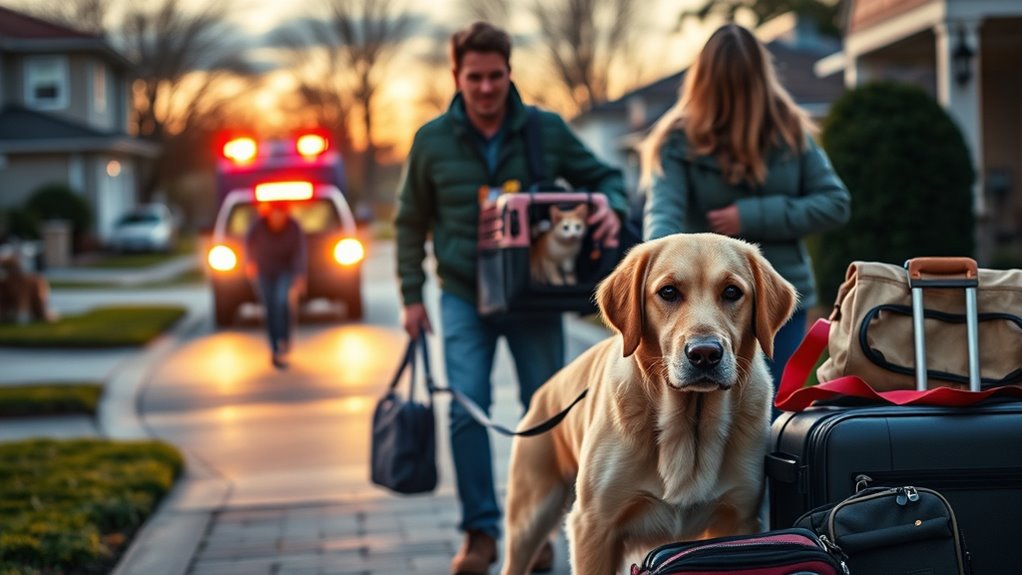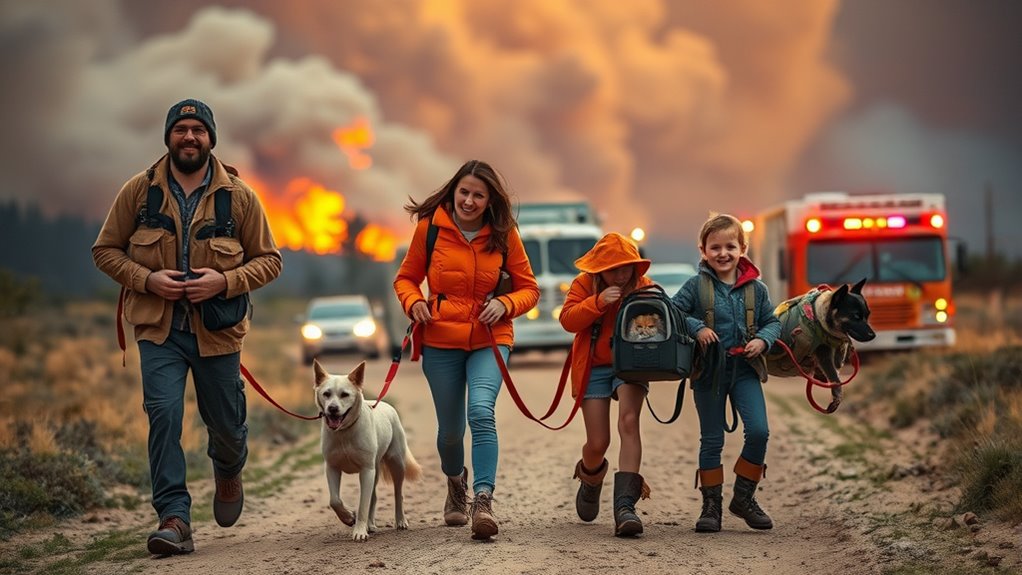To evacuate with your pets effectively, start by creating a detailed plan with multiple escape routes and nearby safe shelters that accept animals. Pack an emergency kit with food, water, medications, and familiar items, and keep it easily accessible. Practice your evacuation procedures regularly so your pets stay calm and secure. During an emergency, stay composed, use sturdy carriers or harnesses, and keep ID tags and recent photos handy. Continue exploring for more tips to make certain your pets stay safe and stress-free throughout the process.
Key Takeaways
- Prepare an emergency pet kit with essentials and keep it in an accessible, organized location.
- Create multiple evacuation routes and identify pet-friendly shelters beforehand.
- Practice evacuation drills to familiarize pets with transport procedures and reduce stress.
- Secure pets in sturdy carriers or harnesses during evacuation, and keep ID tags and photos updated.
- Establish a safe, familiar space at the destination, monitor pet health, and maintain routines post-emergency.

When an emergency strikes, evacuating with your pets can be stressful, but proper planning makes the process smoother. The key is to prioritize pet safety by preparing in advance and having everything ready to go. Start by assembling a dedicated emergency kit specifically for your pets. This kit should include essential supplies like food, water, medications, and any special items your pet needs, such as toys or comfort items. Keep this kit in a designated, easily accessible location so you can grab it quickly during a crisis. Having all your emergency supplies organized and ready ensures you won’t waste precious time searching for things when seconds count. Additionally, understanding pet behavior in emergencies can help you respond more effectively and keep your pet calmer during stressful situations.
Next, create a detailed evacuation plan that includes multiple routes out of your home and nearby safe shelters that accept pets. Share this plan with everyone in your household so everyone knows their role. Practice evacuating with your pets periodically so they become familiar with the process, reducing their stress during an actual emergency. When it’s time to evacuate, keep your pet secured in a sturdy carrier or harness to prevent panic or escape. Never force your pet into a carrier at the last minute; getting them comfortable with their transport method beforehand can considerably ease anxiety.
During the evacuation, stay calm and speak soothingly to your pet. Remember that your behavior influences their stress levels, so maintaining a composed demeanor helps keep your pet calmer. Keep your pet close and ensure they are wearing identification tags with current contact information. If possible, have a recent photo of your pet on hand in case you get separated. Also, remember to bring your pet’s emergency supplies with you—these are vital in case you need to stay in a shelter or unfamiliar environment for an extended period.
Once you arrive at your designated safe location, set up a familiar space for your pet using their favorite blanket or toy from home. This helps provide a sense of security amidst the chaos. Keep your pet indoors or confined in a safe area, away from hazards, and monitor their health constantly. After the emergency subsides, continue to prioritize pet safety by gradually re-establishing routines and checking for any signs of stress or injury. Being prepared with pet safety measures and emergency supplies not only keeps your furry friend safe but also gives you peace of mind during a stressful situation. Proper planning and calm execution are your best tools to guarantee your pets come through emergencies safely and comfortably.
Frequently Asked Questions
How Can I Prepare My Pet for Unexpected Evacuations?
Imagine your pet’s emergency kit is as essential as your trusty smartphone. You should prepare pet travel tips, like packing a favorite toy, food, and water, and keeping a recent photo for ID. Practice quick evacuations, and create an emergency communication plan with neighbors or shelters. Staying calm and prepared helps your pet feel secure, making sudden evacuations less stressful for both of you.
What Should I Include in a Pet Emergency Kit?
You should pack a pet emergency kit with essentials like pet travel accessories—leashes, carriers, and food bowls—and enough pet food and water for several days. Include favorite toys and a blanket for comfort. Don’t forget to add your emergency contact info and a recent photo of your pet, in case you’re separated. This way, you’re prepared to keep your pet safe and comfortable during any unexpected evacuation.
How Do I Find Pet-Friendly Evacuation Shelters?
You can find pet-friendly evacuation shelters by checking local government websites, which list pet shelter locations. Call ahead to confirm availability and any restrictions. Also, explore transportation options like pet carriers or vehicle arrangements that accommodate your pet. Remember, verifying shelter policies beforehand guarantees a smoother evacuation. Trust that planning ahead makes a stressful situation more manageable, and knowing where to go helps keep your pet safe and close during emergencies.
What Are the Best Ways to Keep Pets Calm During Evacuation?
To keep pets calm during evacuation, you should address pet anxiety with calming techniques like familiar toys and blankets. Speak softly and use a calm voice to reassure them, and keep their carrier in a quiet, comfortable spot. Avoid sudden movements and loud noises that can increase stress. Providing treats and familiar scents helps create a sense of security, making the process less frightening for your pet.
How Can I Ensure My Pet’s Medical Needs Are Met During Emergencies?
You can guarantee your pet’s medical needs are met during emergencies by keeping their veterinary records and medication storage organized and accessible. Pack a portable kit with current prescriptions, necessary medications, and copies of vet records. Confirm you have extra medication if possible, and know the location of nearby emergency vets. Staying prepared helps you quickly address your pet’s health needs and reduces stress during evacuations.
Conclusion
Remember, planning ahead makes evacuations smoother and less stressful for you and your furry friends. Pack essentials, keep your pets’ ID updated, and have a go-bag ready—just like a seasoned adventurer preparing for a quest. Don’t forget to stay calm and reassuring, even if you feel like you’re living in a sci-fi movie. With these steps, you’ll be ready to face any disaster, just like a true hero in your own story.










